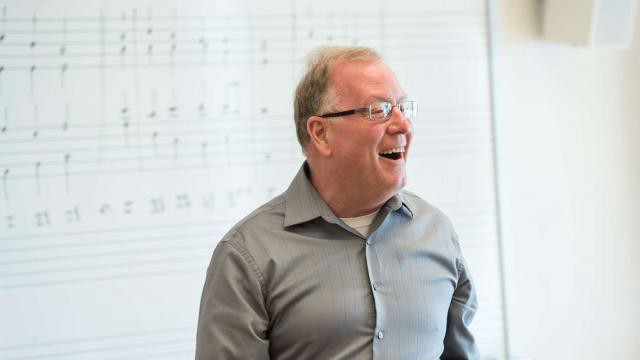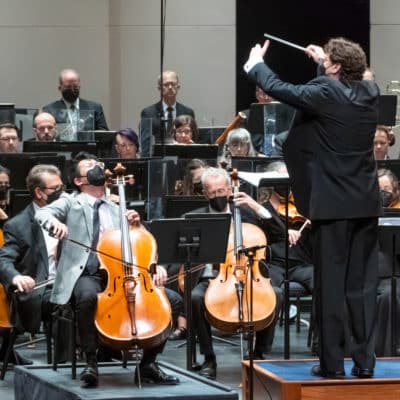Katherine Balch – Artifacts, Concerto for Violin and Orchestra (world premiere)
One particularly pleasant corner of the repertory is occupied by works that composers have written for good friends, often with that friend’s input and contributions. The Brahms Violin Concerto comes first to mind: Brahms wrote it for Joseph Joachim, one of Brahms’s earliest boosters and a faithful collaborator down the years, and it was the result of so much give-and-take between the two artists that one rather wonders if it might warrant a hyphenated attribution of Brahms-Joachim. Felix Mendelssohn wrote his genre-changing Violin Concerto for his close colleague Ferdinand David; Bartók composed his warm and lyrical Third Piano Concerto for his wife Ditta. It’s a sizeable list of terrific stuff, a testimony to the role that friendships have played in shaping music history.
Katherine Balch joins that select company in writing Artifacts, a violin concerto for Robyn Bollinger. “Robyn and I have been friends since our undergraduate years at New England Conservatory, and I’ve been wanting to write her a piece for a long time,” says Balch. “I wanted to take the repertoire Robyn and I love and have shared conversations over, and turn it into something not only in my own voice, but also into something I hope elevates/highlights the incredible personality Robyn brings to her performative practice.”
As a result, Artifacts takes as the departure point for each of its four movements a particular piece in the solo violin repertory—Berio’s ‘Sequenza’, the Paganini Sixth Caprice, the Sarabande from Ysaÿe’s fourth violin sonata, and Sciarrino’s sei capricci. Balch tells us that “while there are not really direct ‘quotes,’ there is often the illusion of quotation, or referencing the pieces in some personal way.” But it’s not necessary to recognize the pieces being referenced in order to enjoy the concerto. “I want to capture and try to share a bit of the magic I experienced listening to the music I love,” says Balch. Then she adds an altogether critical proviso: “filtered through my own voice.”
We’ll all have to wait to hear Balch’s new piece premiered on May 5, but to whet your appetite for Robyn Bollinger’s virtuosic violin skills, here she is performing Bach’s Ciaccona.
Anton Bruckner – Symphony No. 7 in E Major (1883)
https://www.youtube.com/watch?v=2XfhRC03Riw
Nowadays it’s easy to get to Ansfelden, Austria. Just take the A1 westbound out of Vienna and after a while Ansfelden will be on your left, immediately following the exit for central Linz. Ansfelden turns out to be an altogether nice little place. There’s a budget motel that offers a passable complimentary breakfast. There’s a good Chinese restaurant with a popular lunch buffet. There’s a McDonald’s.
And just a short walk away is the house where Anton Bruckner was born in an Ansfelden that was a world removed from today’s pretty suburb. Bruckner’s Ansfelden was an impoverished rural hamlet with more cows than people and shortages both of food and decent jobs. It must have seemed like the end of nowhere to a talented young chap like Anton Bruckner, son of a village schoolmaster. His father got him started in music, then in his early teens he was sent off to the nearby Augustinian monastery of Sankt Florian, which was to play a critical role throughout his life. (And posthumously as well: he’s buried in the monastery’s crypt.) The sound of the mighty Sankt Florian organ runs throughout Bruckner’s works, as does the monastery’s reverent, timeless atmosphere.
Organist at Sankt Florian, ditto in nearby Linz. It was a quiet, unassuming life. He studied mostly via correspondence with the renowned music theorist Simon Sechter, and when Sechter died in 1868 Bruckner (reluctantly) moved to the Big Apple and took over his beloved teacher’s theory classes at the Vienna Conservatory. The shy and unsophisticated Bruckner, a village and monastery man down to his toes, was a poor fit for Vienna’s toxic musical politics. He had a rough time of it with both the Viennese intelligentsia and the critics; Brahms referred to him as “that bumpkin” and arch critic Eduard Hanslick skewered one of his works as a “symphonic anaconda.” But he persisted amidst a steady shower of brickbats, continued to produce luxuriantly epic symphonies, and eventually found a certain measure of success with Viennese musicians and their notoriously fickle public. He stayed unmarried—not for lack of trying—and died in his humble but comfortable Vienna apartment at the age of 72. It took a while for posterity to catch on, but catch on it did and nowadays Bruckner enjoys an enviable reputation as a supreme master of the late Romantic symphony. His music even survived being appropriated by the Nazis, a tribute indeed to its fundamental nobility and goodness.
Time is the essential element in a Bruckner symphony. It is not our time; it is Bruckner’s time; it is the time of the unruffled pastures of Sankt Florian; it is the time of nature and the gradual unfolding of the seasons. To expect otherwise from a Bruckner symphony is to wind up with the white knuckles and cracked tooth enamel of a seething driver stuck in rush-hour traffic. Far better to forget about the freeway and think instead of carriages on sun-dappled country roads, where other travellers are rarely encountered and our time of arrival is mostly up to the horse.
The Bruckner Seventh Symphony stands apart from its predecessors as having been accepted as a repertory item almost from the get-go. Bruckner finished it in September 1883, and two now-legendary conductors—Arthur Nikisch and Hermann Levi—set it on its way in 1884 and 1885, respectively. Amazingly enough, it had made its way to Chicago by 1886 thanks to that enterprising American conductor Theodore Thomas. Its immediate and lasting popularity isn’t at all difficult to understand. It’s not quite as lengthy as most of its brethren, but most importantly, it has a special sweep and a compelling inner urgency. Even if it might seem silly to describe an hour-plus symphony as economical, the word is actually quite apt. Impressively grand, majestic, and passionate, the Bruckner Seventh propels itself firmly along its destined journey. It isn’t just that it comes off as good. It comes off as right.
Program Annotator Scott Foglesong is the Chair of Musicianship and Music Theory at the San Francisco Conservatory of Music, and a Contributing Writer and Lecturer for the San Francisco Symphony. He also leads the ground-breaking new music education course for adults Fresh Look: The Symphony Exposed, which returns for a second year this summer.
EPIC BRUCKNER takes place on Sunday, May 5 at 4 PM at the Lesher Center for the Arts in Walnut Creek. Tickets start at $42 / $20 for students 25 and under with valid Student I.D. and can be purchased online or by calling the Lesher Center Box Office at 925.943.7469.




